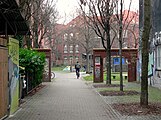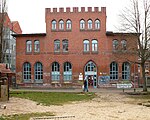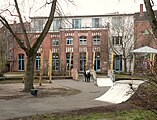Sprengelgelände

The Sprengel terrain is a left alternative square in the district of North City in Hannover . It was built on the former factory site of the chocolate factory Sprengel , which in the 1980s occupied was and become a center of political uprising developed.
story
In 1895, the steam chocolate, candy and confectionery factory B. Sprengel & Co. moved into its newly built factory on Schaufelder Straße. On the back of the site, in 1934, she had an administration building built at Glünderstraße 8 based on a design by the architect Karl Siebrecht . After the takeover of the Sprengel factory in 1979 by the chocolate manufacturer Hans Imhoff and the closure in 1980, the facilities were sold to a Hamburg property speculator . A massive lack of living space and the desire for autonomous ways of life led to disputes about the use of the fallow industrial facilities. Under the title Sprengel, an opportunity for the north city. In a plea for preservation and conversion , a planning cooperative developed proposals for a change in the use of the largely intact factory building for the benefit of the people of Nordstadt. In 1981 and 1983 parts of the demolition site were occupied and cleared again at short notice.
Around the same time as the events in Hanover , the Stollwerck occupation, which has numerous parallels, developed in Cologne's Severinsviertel .
After the Sprengel investor went bankrupt in 1985 , the city of Hanover acquired the property on October 1, 1987 for 3.6 million DM from the bankruptcy estate and planned the demolition of the building as part of a municipal redevelopment program . Autonomous suitcase factories from the opposite, also disused, occupied the 16,000 square meter industrial area in the summer of 1987 again under the motto of living and working in old factories . With improvised construction measures, they set up living space for around 50 people, studios , workshops, pubs and a people's kitchen . The groups, made up of punks , artists, students and autonomous people, organized themselves into wings and kitchens. Parts of the local population also showed solidarity with the self-appointed repair workers , and the Green Alternative List (GABL) opened a branch on the site in 1988. At the same time, there was growing displeasure in conservative circles about "the heap of civil horror":
- For months they have been able to read in the newspaper what the world thinks of them: nothing. When a search for RAF members in the district is called "at the Sprengelände". After shoplifting or fights, the perpetrators disappear “in the direction of the Sprengelände”. When firefighters were prevented from extinguishing a burning dumpster on the university property one kilometer away, the police "did not rule out the possibility that the stones and bottle throwers might have come from circles in the nearby blasting area." The representatives of the rule of law call such incidents “offenses related to districts”, and conservative local politicians like to use them as an opportunity to demand “immediate evacuation”.
The disputes and negotiations with representatives of politics and administration about the future use of the property dragged on for years, were accompanied by eviction suits and culminated in the days of chaos that made the demolition site the center of street battles between punks and police in 1995 . Internal disputes and resentment between autonomists and punks, whose homosexual and misogynistic behavior and violence were rejected by many residents, intensified the joint struggle against the city, state and police. After voluntarily withdrawing from part of the building, a binding solution was found for the residents of the suitcase factory in the form of a long-term lease . After the male-dominated period of physical confrontations, many wanted an end to the aggression and passed a quota for women , which contributed to the fact that 25 years later two thirds of the local population were female.
Renovation and use
For the redevelopment of the northern part of the city, decided in 1984 and completed in 2007, 65 million euros in urban development funds were used alongside other public and private investments. On the site of the former Sprengelfabrik, a 150-meter-long connecting path was created within the block between Schaufelder Straße and Rehbockstraße and renamed Klaus-Müller-Kilian Weg in memory of the deputy district mayor who died in 2004 . New green spaces and playgrounds were created on the former commercial space, and apartments and offices for district-related services were created in the factory building on Schaufelder Straße. A new building with 25 apartments was built on the rear part of the property. The former machine house was converted into a cooperative project for communal living, and the administration building on Glünderstraße 8 was made usable as a student residence. A district center was set up in the community school, and the Mäuseburg day-care center moved into the former gymnasium . The suitcase factory and adjoining areas were left to the sponsoring association Alternatives Wohnen und Arbeit auf dem Sprengelgelände eV , in which mostly people from the time the Sprengel was occupied had been formed.
Infrastructure
The Sprengel area has an established infrastructure with event rooms and meeting points, care facilities, advice centers and workshops, most of which arose from initiatives at the time of the squatting and were able to establish themselves. In his documentary "Sprengel - a piece of milk and honey", named after an old advertising slogan of the chocolate manufacturer, the filmmaker Ralf-Peter Post traced the development of the Sprengel site and its residents.
Nordstadt district center in the former community school

The community school was built before 1895 as a primary school building and was used as a vocational school from 1930 to 1955 . In 1963, the Sprengel company bought the building and used it until the plant was closed. In 1983 the school was occupied and twice evacuated after brief police operations. After that it passed back into the ownership of the city and was subordinated to the cultural office . Trägerverein the public school, the association founded in 1983, is the district center Nordstadt eV houses as self-governing culture and communication center today district center numerous groups and associations, and is itself the promoter of cultural projects in the fields of art, theater, dance and music. The permanent facilities include the cinema in the Sprengel, the Nordstadt Theater, the Chaos Computer Club Hannover, a café, a children's shop, a self-help bicycle workshop and various advisory services.
Cinema in the Sprengel
One of the first cultural projects on the Sprengelände was an improvised cinema in an occupied house, where the investor had already torn down the outer facade. After three months, the game ended after the city administration was sent off. Films were then shown open-air at different locations in the northern part of the city until a cooperation with the Film and Video Cooperative was established. In October 1992, a cinema was again set up in the community school on the Sprengel site, which quickly developed into a hotspot as a cinema in the Sprengel , with a wide-ranging and unconventional program that survived the period of occupation and received numerous awards. The cinema in the Sprengel received the Lower Saxony Annual Film Program Award 20 times in a row ; In 2002, 2006, 2012 and 2015 it was awarded the nationwide cinema prize of the Kinematheksverbund and in 2016 the Lotte Eisner Prize for outstanding non-commercial programming. In Hanover, the non-commercial cinema in the Sprengel is the cheapest and last cinema that consistently shows no advertising. It is run collectively by around 15 volunteers and has received regular funding from the city of Hanover since 2015.
Gay pig
In 1990 the sponsoring association of an alternative gay cultural center (TASK) , which had recently been founded, took over the premises in the social wing of the Sprengel area. The gay sow's opening gala on January 8, 1991 was followed by an eviction notice the following day . A year later, a guarantee of existence was granted in the red-green coalition agreement. The gay sow was repeatedly the target of assaults, break-ins and arson by punks who lived on the premises in the mid-1990s . Today the Schwule Sau is an event center for the queer community. The program includes parties, women's pub evenings, readings , exhibitions, cabaret , discussion events, concerts and theater performances. The Schwule Sau is collectively organized, non-commercial and run by volunteer work. In 2020 it became known that the city of Hanover intends to terminate the premises because the building is in dire need of renovation.
Storm bell
The storm bell is operated by the association living and working on the Sprengelgelände eV and is an alternative pub , former occupation café and venue for exhibitions, parties and live music.
Film contributions
- Documentary: Sprengel - a piece of plenty by Ralf-Peter Post
- Gerda Valentin: Documentary about life on the Sprengel site
- 20 years Chaostage 1995 (Hello Germany, ZDF, 2015) ( Youtube )
literature
- Ute Wieners: Sprengel for everyone . Autobiographical narratives. Edition Region + Geschichte, Neustadt am Rübenberge 2017, ISBN 978-3-930726-32-5 .
- Gudrun Fiedler , Detlef Siegfried , Susanne Rappe-Weber (eds.): Collect - develop - network. Youth culture and social movements in the archive (= youth movement and youth cultures. Yearbook . Volume 10 ). Vandenhoeck & Ruprecht, Göttingen 2014, ISBN 978-3-8471-0340-0 , p. 117–118 ( google.de [accessed December 13, 2020]).
Web links
- Newly used industrial facilities: Sprengel site. In: hannover.de. April 27, 2020.
- Sprengel for everyone! In: Kulturzentrum-Faust.de . (Project with archive material on the history of the demolition site).
- Sprengel - an opportunity for Hanover. (pdf; 11.1 MB) Nordstadt district forum, 1988.
- Klaus Mlynek , Waldemar Röhrbein : Chronicle of the City of Hanover from its beginnings to 1988. (pdf; 1.7 MB) In: City Archives Hanover . October 30, 2018 .
- Klaus Mlynek, Uta Ziegan: City Chronicle 1989-2003. (pdf; 3.7 MB) In: Hannover City Archives. September 15, 2020 .
- On the disputes over the gap between autonomists and punks. In: Zeck. The info from the flora. February 1996, pp. 9-10 .
Individual evidence
- ↑ Sprengel information event . City of Hanover, City Planning Office, 1987, p. 4 , accessed on December 16, 2020 .
- ↑ Company Sprengel 1851-2015. CityA H 3.FA.064. In: Hannover City Archives. Accessed December 24, 2020 .
- ↑ Sprengel, an opportunity for the north city. Plea for conservation and conversion. In: Kulturzentrum Faust. Planner cooperative Hanover, 1980, accessed on December 22, 2020 .
- ↑ City Chronicle 18000 BC - 1988. Hannover City Archives, October 26, 1981, p. 230 , accessed on December 14, 2020 .
- ↑ Sprengel for everyone! In: Kulturzentrum Faust. Retrieved December 14, 2020 .
- ↑ Tour: Sprengelände. In: Nordstadt Online. Retrieved December 14, 2020 .
- ↑ Sprengelgelände. In: Hannover.de. Official portal of the state capital and region of Hanover in cooperation with the Madsack media group, accessed on December 14, 2020 .
- ↑ Bernd Hüttner: "Sprengel for All" in Hanover. In: Rosa Luxemburg Foundation. October 17, 2017, accessed December 14, 2020 .
- ↑ Silke Stokar : 25 years of green. Political life in Hanover. In: GRÜBL. Special edition for the 25th birthday of the Green District Association of Hanover City. 2004, p. 6 , accessed December 15, 2020 .
- ^ Frank Drieschnei: contracts terminated. (No longer available online.) Die Zeit, October 7, 1988, archived from the original ; accessed on December 22, 2020 .
- ↑ Hannes Koch : Construction trailer cleared from the demolition site. In: taz archive. November 21, 1989, accessed December 14, 2020 .
- ↑ Gunnar Menkens: The peace in the north city was our bargaining chip. In: Hannoversche Allgemeine Zeitung. August 12, 2017, accessed December 14, 2020 .
- ^ House on Sprengel site cleared. In: taz archive. Die Tageszeitung, August 2, 1988, accessed on December 15, 2020 .
- ↑ Franziska Scharsky, Michael Roemer: Restoration Northern city. Final report. City of Hanover, Building Department, Department of Planning and Urban Development, Department of Urban Renewal and Housing, 2007, pp. 17-19 , accessed on December 14, 2020 .
- ↑ Larissa Holzki, Stefanie Nickel: Sprengel site and UJZ celebrate anniversaries. August 23, 2012, accessed December 14, 2020 .
- ^ Redevelopment of Nordstadt. Final report. The Lord Mayor. Building Department, 2007, accessed December 22, 2020 .
- ↑ Christian Nieße: Motion according to §§ 9/31 of the rules of procedure of the Council of the LHH at the meeting of the District Council North on April 26, 2004. April 8, 2004, accessed December 22, 2020 .
- ↑ Tour: Sprengelände. In: Nordstadt-Online.de. Accessed December 16, 2020 .
- ↑ Franziska Scharsky, Michael Roemer: Restoration Northern city. Final report. City of Hanover, Building Department, Planning and Urban Development Department, Urban Renewal and Housing Department, 2007, p. 3,17 , accessed on December 14, 2020 .
- ↑ About us. In: Website of the Bürgererschule - District Center Nordstadt eV Accessed on December 17, 2020 .
- ↑ Bärbel Hilbig: A lucky bag called cinema. Hannoversche Allgemeine Zeitung, October 17, 2014, accessed on December 15, 2020 .
- ^ Wilfried Hippen: Niche cinema in Hanover: anachronism with a screen. In: taz.de. The daily newspaper, accessed on December 15, 2020 .
- ↑ The history of the cinema in the Sprengels. In: Website of the Kino im Sprengel. Retrieved December 15, 2020 .
- ↑ Awards. In: Website of the Kino im Sprengel. Retrieved December 15, 2020 .
- ↑ nordmedia cinema program awards. nordmedia - Film- und Mediengesellschaft Niedersachsen / Bremen mbH, accessed on December 15, 2020 .
- ↑ Pig on ground ice. November 8, 1992, accessed December 16, 2020 .
- ^ War in Hanover. In: squat.net. Radical Server Europe. Casting Movement Technical Services, accessed December 14, 2020 .
- ↑ That's the gay pig. In: website of the gay pig. Accessed December 16, 2020 .
- ^ Event center Schwule Sau worries about its existence in the Hannoversche Allgemeine Zeitung from January 23, 2021
Coordinates: 52 ° 23 '17.4 " N , 9 ° 43' 4.1" E












